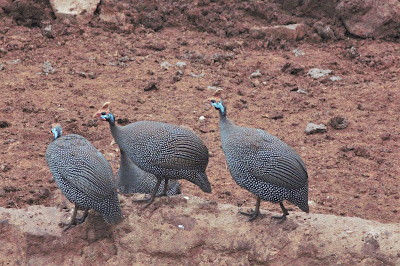Our trip took us to Nairobi and from there north to the Aberdares National Park where we stayed at the Treetops hotel. This was originally a treetop hide for watching wildlife at a nearby waterhole which was gradually developed over the years. Guests reside on the top 3 floors and can watch the waterhole from their rooms, bar, restaurant or special viewing platforms. The rooms are pretty good but in reality the stars of the show are the animals.The hotel's main claim to fame is that Princess Elizabeth was staying there when her father king George VI died, thus becoming Queen Elizabeth II.
On arrival guests are informed of a buzzer system located in every room, overnight if any of the big 5 come through the staff buzz the room and if you want you can get up to watch (you can also turn it off ). They mentioned, Rhino may show, as might Leopard both of which I really didn't believe would. However, about 1am a pair of Rhino appeared and a little later a Leopard. We only managed to get a photo of the Rhino as the cat was too far off in the poor light. And yes the buzzer did go off :)
Also in the twilight I managed to get a (bloody awful) photo of the Blacksmith Lapwing (plover)
The second photo of the Blacksmith Lapwing but at a great distance.
Fairly common around the waterhole were Egyptian Duck, we spotted these most places we stayed during our travels.
The Water Buffalo were regular visitors to the waterhole while we were there, they came down from the hill in a heard of about 45 animals with a good few juveniles along with them. They are fairly cranky and there were constant fights within the heard.
Warthogs were also very common grazing out in the grassy areas beyond the waterhole.
The hotel has a small house in the grounds where Baron Baden-Powell lived out his final years and ultimately died. In addition to having a distinguished military career, Lord Baden-Powell was one of the founders of the Scout movement.
Wandering around the grounds I came across this beauty, a White-Eyed Slaty Flycatcher which posed nicely for photos. These sparrow sized birds are endemic to East and Central Africa.
Speckled Pigeons are pretty common all over central Keyna.
All around the grounds were little flocks of Speckled Mousebirds, these are a beautiful little bird and very active in the bushes and trees. The guide describes them as drab brown but I think that does them a dis-service.
Cute Huh :)
The bird below is a Streaky-Seed Eater which I managed to get a quick photo of before he vanished. A largish brown canary.
The Mountain Thrush (Turdus abyssinicus) below was very common around the area.The bird below doing gymnastics under a child's trampoline is female Black Bellied Sunbird, I think.
I have been through the guidebooks a dozen times and am fairly sure of this and so far Birdforum has not provided any better ideas. I will update if I get any more definitive identifications.
Still trying to identify this little fellow. He is about sparrow sized and a seed eater but so far I have not managed to identify him.
A few African Green Pigeon along with a Rameron Pigeon (Olive Pigeon). There were a dozen or more of the African Greens roosting in a nearby tree.Cape Turtle (Ring Necked) Doves were also about in good numbers
I could never get a good photo of these guys but there was a small colony of Little Swift nesting in the rafters of the hotel.
A bird that I expect I will find all over the world, or at least its been everywhere I have been to date is the Grey Heron.
These curious birds are found almost everywhere in Kenya, the Helmeted Guineafowl can sometimes be found in fairly large flocks although at this site we only saw 6 or 7.
The Greater Blue Eared Starling were very common about the area and flocked in largish groups.
The Baglafecht Weaver at a distance. I really struggled to get a good photo of this bird as it kept disappearing into the tree about 30 yards away :(
Also spotted some Common Bulbul and Barn Swallos but I did not manage to get usable photos of these. This is an amazing place for birds and unfortunately I only had one evening there so did not get out into the surrounding areas, some day I will return.


























No comments:
Post a Comment